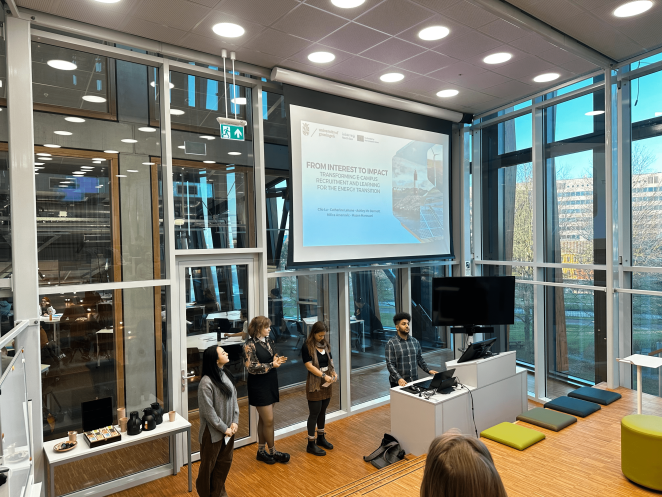How can we encourage young people, particularly women, to pursue careers in the energy transition (ET)?
This question was at the heart of a recent NESSIE event where masters students from the University of Groningen in the program of Islands and Sustainability presented their research. With women currently comprising just 22% of the EU27 ET workforce, addressing this imbalance is important to foster a more diverse and effective workforce, and is a key objective within NESSIE’s activities.
The research focused on recruitment and engagement strategies for Vocational Education and Training (VET) students, offering insights into what motivates young people to choose a career in ET and how we can better support them on this journey.
What Students Need
The research highlighted the importance of aligning education with values and providing opportunities for hands-on learning. The study interviewed 5 focus groups of FIRDA students with questions ranging from why they are studying their energy-related field, and what aspects of their educational experience have both encouraged and discouraged their career journey. Many students expressed a deep intrinsic motivation for sustainability, with over 80% saying this was a key driver in their career decisions.
Practical experience, such as internships and apprenticeships, was repeatedly identified as a crucial factor in building confidence and skills. The students interviewed for the research also emphasized the role of mentors and teachers in shaping their career choices. These influential figures can bridge the gap between education and the workforce by providing guidance and encouragement.
Beyond the classroom, students noted a lack of accessible information about ET careers and programs. Clearer communication through engaging formats like videos, brochures, and peer-created content could help raise awareness about the study experience and career path, demystify the industry, and inspire more students to enroll.
The Unique Challenges for Women
For women, entering the ET workforce presents additional barriers. The female students in the focus group felt isolated as a minority, with few relatable role models to look up to. They also felt like they faced implicit biases that made them feel undervalued compared to their male peers.
One striking insight was how women are less likely to apply for opportunities unless they meet all qualifications, whereas men often apply even if underqualified. This hesitation stems from a lack of confidence and a sense of not belonging—issues that can be addressed by developing a stronger sense of community and representation.
The value of peer-led initiatives was particularly clear. Women who had access to peer discussions and mentorship felt more supported and motivated. Building networks where women can share experiences and learn from one another is essential for creating an inclusive environment.
What can we do about it?
The UG presentation offered valuable takeaways for recruiting and engaging the next generation of ET professionals:
- Create Relatable Content: Let students share their experiences to inspire peers through blog posts, videos, or social media.
- Focus on Hands-On Learning: Practical training like internships and apprenticeships must be central to ET education.
- Highlight Women in the Industry: Showcase women in ET roles to normalize their presence and provide relatable role models.
- Foster Community: Encourage mentorship, peer-led discussions, and dedicated events like “Girls Days” for open houses and building networks of support.
- Engage Parents: Parents play a significant role in career decisions—provide them with clear, accessible information about ET education pathways.
Looking Ahead
The UG students' research emphasized that career decisions are not made in isolation—they are shaped by a cyclical process influenced by values, experiences, and support systems. By addressing gaps in communication, representation, and practical opportunities, we can build a pipeline of motivated, diverse students ready to lead the energy transition.

